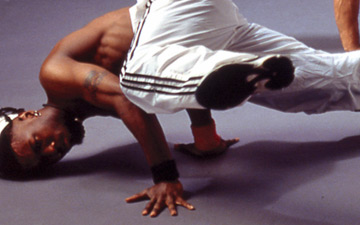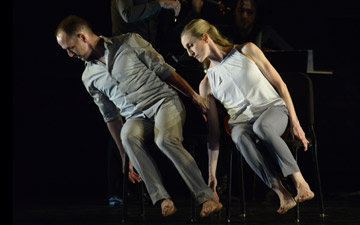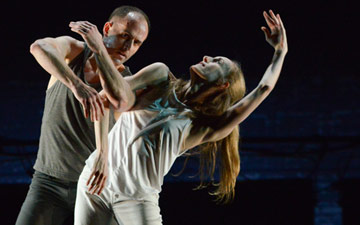
© Jamie Kraus. (Click image for larger version)
Jacob’s Pillow Dance Festival
Brian Brooks / Moving Company
Flight Study, Quiet Music, Closing Distance
★★★★★
Becket, Jacob’s Pillow, Henry J. Leir stage
23 July 2021
Streamed August 5-19 2021
www.bbrooks.org
www.jacobspillow.org
For this viewer, Brian Brooks’ concert at Jacob’s Pillow provided a powerful reentry to live dance after eighteen months of making do with shadows on screens. The program’s two major works read as responses to the pandemic, although Closing Distance premiered in January 2020, before the full force of Covid-19 had struck. Flight Study, however, was made last October, when there was no doubt about the devastation being wrought. Both works are purely abstract. They make no overt reference to the pandemic, and twenty years from now may elicit a response unrelated to it. But seen today, they speak to this catastrophic moment with profound eloquence.
Until last year, there had been dance at Jacob’s Pillow every summer since its founding in 1933. In 2020, the virus reduced the festival to online screenings, and the effects of Covid are still being felt in a number of ways. These include all concerts being presented at the Henry J. Leir outdoor stage, rather than, as in the past, at the Pillow’s indoor venues. But what could have been a disadvantage, actually worked in Brooks’ favor. If anything, the company’s dances were enhanced by the setting, which is dramatic. The stage is arched over by deciduous trees, while in the background, a towering sky dwarfs a thin line of the Berkshire hills.

© Jamie Kraus. (Click image for larger version)
Reversing the chronological order of the dances, the program opened with Flight Study. The company’s eight dancers, dressed in black, are arranged in an upstage corner as the opening of Bryce Dessner’s score, Aheym, strikes like a hammer blow. Dessner is a rock musician, as well as a classical composer, and he fully understands how to use beat and rhythm to influence emotion. The music’s dark intensity is only occasionally modified by moments of calm. Brooks’ choreography meets the score with complex patterns of theme and variation, repetition, and reiteration. The choreography, which in lesser hands might surrender to the music’s force, instead uses it, meeting emotional intensity with a formal complexity that both complements and unites music and movement. Throughout the work, the dancers never touch, and as one person approaches, another moves away. Yet we sense a community in the way movement is echoed, repeated, varied, and then resolved. The dance remains formal throughout, leaving it to the body in movement to convey feeling.
When I saw Flight Study the first time at the Leir stage, I thought of the dancers as fledgling creatures learning to fly, but after viewing the dance further online, I was less convinced of so literal an interpretation. Now, as the title states, I find it a study of flight, itself, and what flight must do to overcome the unrelenting, downward pressure of gravity.

© Jamie Kraus. (Click image for larger version)
In contrast to Flight Study, Closing Distance is costumed in whites and light grays. Karen Young was the designer for both works. The score, Partita for Eight Voices by Caroline Shaw, combines what sounds like verbal descriptions of geometrical forms and lines with mostly wordless choral sections that are sometimes reminiscent of Shaker hymns. The dance explores touch, something we were deprived of for many months of the pandemic, before inoculation provided a modicum of normalcy. Brooks explores touch in a variety of ways, excepting the erotic and violent. Touch here is invariably gentle. It supports, connects, aids, lifts. It is celestial, in every way light to Flight Study‘s darkness. Even in a central duet for Carlye Eckert and Evan Fisk the atmosphere is intimate but impersonal. I was reminded of Edwin Denby’s comment about dancers who, like angels, tell of emotion without themselves experiencing it.
The two major works were separated by the premiere of Quiet Music, a solo Brooks made for himself. He did not otherwise appear in the concert, and later commented that he wanted to dance beside the company but not with them, since he considered Flight Study and Closing Distance to be theirs. Quiet Music, set to a score of the same title by Nico Muhly, is a meditative piece. Watching it was like seeing into a choreographer’s working process, of how he might explore and define movement in the creation of a dance. In this case, though, creation had to come when the choreographer’s usual environment had been totally disrupted, and when conditions were harsh. Quiet Music made an effective counter to the larger scale company dances and in its own modest way, was emphatic. Out of necessity comes creation. It was as if to say, this is how it is done.

© Jamie Kraus. (Click image for larger version)
In a post-performance talk, Brooks spoke about how difficult the dances were to bring to the stage. New York, where the company is based, was for many months in lockdown and the dancers could not rehearse in person. That meant that most of the Flight Study rehearsals had to be conducted on Zoom. It’s a situation that sounds nearly impossible, especially in a complex ensemble piece that demands precise timing. As for Closing Distance, the company hadn’t rehearsed it for seven months before arriving at the Pillow for a ten-day residency last October, when they had to reassemble it. But as Brooks said, you adapt or you retire. Certainly in this case Brooks and his company rose to the many challenges they faced, producing works of compelling power and beauty. The dancers, each a strong individual presence include, in addition to Eckert and Fisk, Zack Gonder, Noelle Hauptman-Anderson, Leo Hishikawa, Taylor LaBruzzo, Stephanie Terasaki and Spencer James Weidie.

















You must be logged in to post a comment.